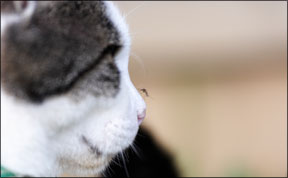As springtime arrives throughout the U.S., the steamy days and nights of summer cannot be far behind. This means, of course, a proliferation of mosquitoes. For you, this is an annoyance. For your cat, these bothersome little creatures can pose a major health problem. 288 Among all of the various disorders that can endanger a cats physical well-being and perhaps threaten its life, few are more insidious than feline heartworm disease, a potentially life-threatening condition that occurs when a parasitic worm called Dirofilaria immitis gets into an animals system. And the only way in which this worm can enter your cats body is through a mosquito bite. The infection occurs when a mosquito pierces a cats skin and, in so doing, allows entry of heartworm larvae that it has picked up from another animal, most commonly an infected dog, into the victims bloodstream. Over time (typically about eight months) these larvae thrive and develop in the bitten cats body, initially in the subcutaneous tissues directly beneath the skin, then in the muscle tissues and eventually in the right ventricle of the animals heart, in its lungs and in the arteries associated with those vital organs. But the worms can cause problems before they are fully grown, says Dwight Bowman, DVM, PhD, a professor of parasitology at Cornell Universitys College of Veterinary Medicine. “Between 60 and 100 days after the initial infection,” he says, “you can start to see signs of pathology in an affected animals body, even though the parasite has not yet reached maturity.” The immature worms arrival into the small arteries in the lungs initiates a severe inflammatory response that damages not only the arteries, but also the bronchioles (small airways) and alveoli (air sacs where gas exchange in the lungs takes place). Furthermore, he points out, although the name of the disease suggests that the disorder mainly affects the heart, the mature parasite eventually resides, for the most part, not in the heart, but in the pulmonary arteries, which carry blood from the heart to the lungs. And in the cat, the disease primarily affects the lungs, not just the heart. Veterinary scientists have coined a new term – heartworm associated respiratory disease, or HARD – to describe the lung disease that heartworms cause. For additional information about HARD and feline heartworm disease, see www.knowheartworms.org. Severe Damage. The various disorders brought about by heartworm infection are in part attributable to the impressive size of the parasite – white, spaghetti-like creatures that can grow to be nearly a foot long – and to the inflammatory response that immature and dying adult worms induce. In an advanced infection, especially in dogs, the worms damage the walls of the pulmonary arteries and impede the passage of blood through them, which results in excessive strain on the heart as it attempts to pump blood through those packed vessels. In some cats, a heartworm infection may disappear spontaneously, possibly because an animal has developed an immune response that is sufficiently strong to kill the parasite. The immune response itself, though, is believed to cause many of the signs commonly seen in feline heartworm disease. In most cases, the infection will progress steadily, with nonspecific clinical signs that may mimic the indications of many other feline diseases. Signs of Infection. The most common clinical signs of heartworm infection include: intermittent vomiting (sometimes of blood as well as of food); diarrhea; rapid and difficult breathing, coughing and gagging, all of which may be confused with feline asthma or some other bronchial disease; loss of appetite; lethargy and weight loss. In some cases, a cat may survive a heartworm infection for an extended period of time before succumbing to another feline disorder. In an acute case of the disease, a cat may die suddenly. “In any case,” says Dr. Bowman, “the prognosis is not good. Heartworm disease is not something that you want your cat to get.” Diagnosing feline heartworm disease will typically involve a complete blood count and blood chemistry profile, chest X-rays, a test to determine whether the patients blood contains antibodies to the parasite and a test to see whether adult heartworm proteins are present in the blood. In addition, ultrasound imaging may be able to visually reveal the presence of heartworms in the heart or pulmonary vessels. Unfortunately, says Dr. Bowman, heartworm disease in cats – unlike the condition in dogs – is untreatable. The powerful substances that are regularly used to rid a dog of the infection, he explains, can be fatal to a cat. Treatment Options. Most cats that are diagnosed with heartworm infection but are not showing severe clinical signs will be monitored to see whether the condition might resolve itself spontaneously. Cases where there is evidence of disease in the lungs and associated blood vessels can be monitored with periodic chest X-rays. Supportive therapy with small, gradually decreasing doses of prednisolone is recommended for cats with clinically confirmed evidence of lung disease. Cats with clearly apparent signs of heartworm disease may require additional supportive treatment in the form of intravenous fluids, oxygen therapy, cardiovascular drugs and antibiotics. Protective Measures. The key to providing year-round protection against feline heartworm disease – especially in the warm, muggy sections of the U.S. where mosquitoes proliferate – is the routine administration of such preventive medications as selamectin, milbemycin and ivermectin to all cats in a household. “With the approval of their veterinarians,” says Dr. Bowman, “all cats should definitely be given these medications.” Cat owners can obtain additional information regarding heartworm by contacting the American Heartworm Society at www.heartwormsociety.org.



